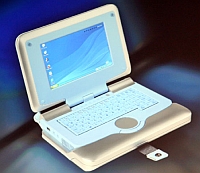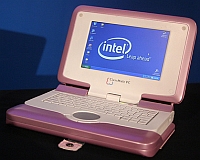Capping a South American educational donation and implementation press tour, Intel president and CEO Paul Otellini introduced the Eduwise Classmate PC notebook, and hopeful OLPC 2B1 killer, during his Intel Developer Forum keynote presentation in San Francisco yesterday.
The Classmate PC is a formidable system, it has twice as much RAM and flash memory, and a significantly faster processor than the 2B1 Children's Machine for only about $100 more. It runs an embedded version of Windows XP, preserving the WinTel duopoly, though it is rumored to support Linux also.
In addition, unlike the still in development One Laptop Per Child computer, the Classmate PC already exists and is in real-world trials under Intel's World Ahead program. According to AllAfrica.com, Intel has Classmate PC's implemented in a government junior secondary school in Jabi, Nigeria. There four teachers were trained how to integrate computers into their classes with 36 students already using the Classmate PC.
Intel also announced the Classmate PC will be available to 300,000 Mexican teachers by year’s end as part of a larger teacher training initiative. Brazil and India have also agreed to purchase Classmate PC's, but I cannot find any order or implementation information online.
Regardless of hardware differences, it is Intel's implementation approach that is the most striking. Unlike Nicholas Negroponte's myopic focus on laptop production, while calling it an education project, Intel is actually focusing on the messy but much more important technology implementation.
At the most basic level, Intel is designing the Classmate PC to be an educational tool controlled by the teacher. To quote the Trusted Reviews:
In the classroom, the Classmate PC will connect to the teacher’s machine and allow him/her to transmit directly to the desktop of every student. It also means that the teacher can monitor each student’s progress in real time. There are no text books, exercise books, pens or pencils to worry about – all the teacher has to do is place a Classmate PC on each desk before class starts and everyone’s set.An article this summer on CNET News.com had more detail. Michael Kanellos reported that:

As a threat deterrent, the notebook will come with asset-control software, so if it is out of the classroom for too many days, the notebook disables itself.Intel itself may say it the best in its Intel World Ahead, Brazil press kit:The Classmate will also sport a special version of Windows that prevents kids from accessing Internet sites or adding programs that have been designated by parents or teachers as off-limits.
The computer has software that can be used during classroom exercises. If a child tries to surf away from the lesson at hand, a message pops up saying, "Please pay attention to the professor."

The Classmate PC platform is a teacher-student computing solution designed to serve the educational needs in developing countries.Now what does One Laptop Per Child have for a localized pedagogical software solution? Christopher Blizzard says:The platform brings a complete hardware and localized pedagogical software solution that enables classroom and content management. This is being achieved through interaction with local pedagogical content providers and educators.
Classmate PC is made of three key elements, a small form factor, affordable and rugged notebook designed for students, a teacher console unit, and a complete integrated software management solution.
"And with regards to the software, we’re not really building educational software for the laptop. We don’t consider it our job, we’re just building the basic tools to let those kinds of things flourish. And you can imagine that with an install base in the millions that that kind of software is likely to pop up for sale."Which pretty much sums up the entire OLPC implementation plan: if we build it, and you buy at least a million, everything will magically work out. Or an implementation plan that is equal parts arrogance and denial.
So while Intel's Classmate PC is only a cheaper PC and not the paradigm shifting technology of the OLPC 2B1 Children's Machine, its World Ahead implementation methodology is just that - a world ahead of the One Laptop Per Child's drop it off at the country's door delivery plan.




Interesting ideas and good visual presentation on this blog, but again the quality of the writing is really poor. Its like reading an angry teen on the bulletin boards and a far cry from professional journalism. Have you considered editing your work or getting someone else to read it and give you feedback? That could really help - just a bit more of an even and considered tone. I don't think its as simple as 2B1 BAD - CLASSMATE GOOD! but you come across as almost screaming this out.
i want to oder classmate PC
A few thoughts:
Licensing Windows (of any flavor) costs more than Linux, is that included in the price?
Only $100 more? Is that $100 more than the $100 OMPC target? In which case it is 100% more. Or is it $100 more than the current estimated price (AFAIK $150) in which case it is only 66.6% more? In either case it is significant.
BTW the only estimates of the Classmate price that I have seen said $400, maybe that included the OS.
Doesn't faster processor generally mean more power consumption?
I don't see any mention of battery life, or integrated camera, or mesh networking, so I guess those are not important elements.
I have to concur with the above poster, you come across as someone with a childish grudge, specifically against Negroponte.
What happened between you? did he flunk you out of a class? Stop you from dating his daughter? Ignore your emails?
What the two of you don't realize, Jason and Michael, is that governments may be foolish enough to spend millions on a shiny new technology that lacks any developed implementation plan. That would be disaster for entire countries.
While I don't think the Classmate PC technology is anything more than a cheaper standard laptop, and certainly not the technology revolution of the 2B1, at least Intel adjusts its strategy based on real world feedback and is incorporating existing educational systems into its implementations.
Negroponte does not:
http://www.olpcnews.com/people/negroponte/negroponte_to_critic.html
I think that despite the tone which might take you back at first it is always interesting to have opinions "aired" if only to be able to dismiss them or argue the point a little...
I can see why Chris Blizzard doesn't worry himself about edu software. It is because the goal (clearly stated) of OLPC is to provide a Linux platform to run on 2B1.
Now if you spend a few minutes searching the web you'll find out that the community (Linux) is quite active: from Education orientated distri (Edubuntu) to software (Tux4Kids, KDE-Edu etc) to foundations working on this specific topic (Simple End User Linux in Education [http://www.seul.org/edu], the Open Source Education Foundation [http://www.osef.org] etc).
Also, Wayan, you posted the following comment:
"[Classmate PC is] certainly not the technology revolution of the 2B1, at least Intel adjusts its strategy based on real world feedback and is incorporating existing educational systems into its implementations.
Negroponte does not"
Pointing us then to the post where Negroponte is quoted to say that OLPC is like the church or red-cross when it comes to critisism (which is quite obscure).
Do you really think that Nicholas Negroponte is doing everything by himself, and that the hardware and software development process do not / will not take into account the goals laid in paper as well as feedback from real world experience, pilot projects (to come in Thailand) and government with which OLPC is working?
More info on the Intel-Nigeria:
Nigeria’s students welcome Intel’s e-classroom
Nigeria, Africa: A project to make ICT available at all times for pupils in schools in the emerging markets has received a major boost.
http://developingtelecoms.com/content/view/600/26/
I must say I like the Classmate PC approach, bundling hardware and a learning management system. I'm actually working on my first LMS project right now, and besides making the content SCORM compatible, we basically put all the money into the pedagogic (is that the correct term in english). Hardware, and technology, is pretty much useless to discuss, but the content and the way people learn changes very little. Cudos to Intel for running the Classmate PC project, I hope there are actually students/children who get to benefit from it, no matter what configuration the machine has, and I certainly hope they, and others, set aside the millons neccessary to build (preferrably) open source learning courses to run on these machines. If not, you will basically have some ok machines for cheap, but the schools will have to pay huge sums for the actual content, the CMS, and the LMS.
(by the way, there are some open source LMS's out there)
As long as it doesn't have any Windows XP Starter Edition style limitations, not bad. But I still think I'd rather have the OLPC version.
Brazilian teachers already has efforts in developing curricula towards OLPC project: http://wiki.laptop.org/go/Banco_de_atividades_para_o_OLPC.
As the hardware-software infrastructure, the efforts are in early stages yet.
How does the Classmate PC compare to the 2B1 laptop? With twice as much memory, twice as much storage capacity, and a significantly faster processor, the Classmate PC outstrips the 2B1 in terms of specs, and manages to do so for just over $100 more.
Beyond criticism, we experience that blogs are the simplest way to express ones feeling about the topic being discussed. You just have to put your fingers on keys and write the first thing that comes to your mind and you can see it up, visible to hundreds of thousands of people, the very next moment.
I'm struggling to see the relevance of the caption on the picture of two girls. Where does "Insert Nigerian 419 caption here" fit into this blog?
I'm a college graduate, but perhaps not a typical one. I strongly dislike command-and-control pedagogy. On the other hand, I love open source software, gardening, and many other self-rewarding and self-motivating activities.
The above description of the Classmate's "Teacher Control, Asset Management, etc." capabilities makes my stomach turn with memories of cruel elementary school teachers. Again, I don't feel like I'm a typical student.
I'm the proud owner of an XO via G1G1. The above description of the Classmate satisfies me in knowing that I made a good choice in supporting hardware and software made "by students for students" and not "by companies for teachers".
My aspiration is to be a student my whole life. Both using and giving back to the XO is a means towards these ends. In case anyone was wondering, none of the following "students" have given any indication of an original, coherent "implimentation plan" other than merely staying involved and contributing as they could: Kernigan, Richie, Torvalds, Larry Wall, Leibniz, etc.
ya rite but some times its not work yaar. Give me some more info